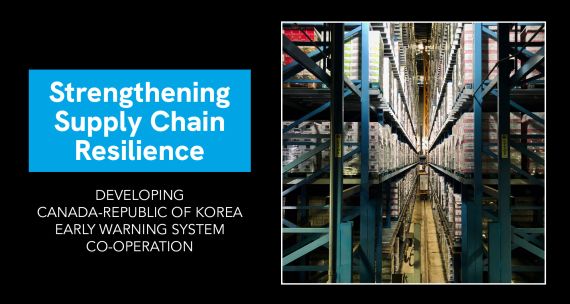South Korea’s rapid economic growth and modernization from the 1960s to 1980s has been described as the ‘Miracle of the Han River,’ and represents a model for successful government-led development. Since the end of the Korean War in 1953, South Korea has transformed from an agrarian economy with a GDP per capita of US$67 in 1953 to the 12th largest economy in the world, with a GDP per capita today of more than US$30,000. South Korea’s success has been closely associated with the ‘developmental state’ model of growth, which is characterized by a central government co-ordinating closely with the private sector to achieve socio-economic development within a short time. The arrival in 2020 of the COVID-19 crisis has further highlighted the country’s capacity to rapidly address new social and economic challenges in the context of global disruption.
In order to guide its economic growth and modernization in the current context, on July 14, 2020 the South Korean government introduced the ‘Korean New Deal,’ a 114.1-trillion-won (C$128.5-billion) mega-package to accelerate the adoption of digitalization and green technologies. If successfully implemented, it will position South Korea as a leader in the digital and green economy of the post-pandemic world. In this context, this policy brief examines the Korean New Deal to identify opportunities and lessons for Canada.
The Korean New Deal
South Korea’s government introduced the Korean New Deal (KND) to facilitate rapid recovery from the COVID-19-induced recession, and to accelerate the country’s adaptation to the structural challenges of the Fourth Industrial Revolution, including the disruption of the labour market through automation and governance challenges created by rapid digitalization. Through the Korean New Deal, Seoul will invest up to 114.1 trillion won (C$128.5 billion) to accelerate a digitalization process centred around ‘DNA’ (data, network/5G, and artificial intelligence), boost green infrastructure with the goal of reaching net-zero emissions by 2050, and strengthen its social and employment safety nets. Fundamentally, the KND has been framed as a job-creating policy projected to create 1.9 million high-quality jobs by 2025.
The KND revolves around three key pillars: Digital New Deal, Green New Deal, and Stronger Safety Net. There are nine broader ‘themes’ or ‘focus areas,’ with 28 specific projects under these themes. This brief focuses on the Digital and Green New Deals, which will be of most interest to Canadian businesses.
Digital New Deal
Through the Digital New Deal, the South Korean government has pledged to invest approximately 44.8 trillion won (C$50 billion) through 2024 in 12 projects in three different focus areas with the goal of accelerating South Korea’s digitalization agenda. The Digital New Deal will not significantly change the direction of Seoul’s policies but will instead add momentum to pre-existing policy directions on digitalization by leveraging the COVID-19 crisis, which has already initiated digitalization in all sectors of the economy.
Specifically, the Digital New Deal will focus on these key themes:
• Stronger integration of DNA (data, network/5G, and artificial intelligence) will incorporate the concept of a ‘Data Dam’ whereby all sectors of the South Korean government and society harness ‘big data’ through the expansion of the 5G network and deployment of artificial intelligence (AI).
• Digitalization of education infrastructure will provide adequate digital infrastructure (internet connectivity and devices) to all students in grades 1-12 and more resources and enhanced training for the remote education sector.
• Fostering the ‘untact’ (contact-less) industry will see Seoul support its smart medical care infrastructure (e.g. remote health) and provide resources to micro, small and medium enterprises (MSMEs) to support their online activities and remote working.
Green New Deal
For the second pillar of the KND, Seoul has committed to investing up to 42.7 trillion won (C$47.6 billion) until 2024 across eight projects under three focus areas. Initially not a part of the KND, the Green New Deal was added after an explicit request from President Moon Jae-in, who emphasized the importance of adding the climate component as a matter of “responsibility to the international community.”
Specifically the Green New Deal will focus on these key themes:
• Green Transition of infrastructure to turn public facilities (e.g. schools, daycares) into zero-energy buildings, as well as restore green ecosystems and build a digitalized management system for clean water.
• Low-carbon and decentralized energy will accelerate the shift from petroleum-run vehicles to electric and hydrogen vehicles, bring smart grids online for more efficient energy management, and promote the use of renewable energy.
• Innovation in green industry will support businesses in the adoption of low-carbon and green practices, as well as support research and development (R&D) and funding for green innovation.
Analysis
The KND is in its early stage, but the large stimulus packages will clearly stimulate South Korea’s digital and green sectors. The private sector and local governments have responded positively to the announcement of the KND. For instance, a day after the announcement of the KND, telecommunication firms SKT, KT, and LG U+ announced that they would be investing 25.7 trillion won (C$28.7 billion) in the national 5G network. Similarly, firms, local governments, and universities have started announcing KND-themed initiatives to support the integration of digital technologies within MSMEs, government services, and talent training.
Commercial / Investment Opportunities
There is a widespread sentiment in South Korea, particularly in the area of cutting-edge technologies, that the goals of the KND cannot be achieved through the country’s domestic capacities alone. Canada’s opportunities within the KND are then clear: There will be new and enhanced investment and export opportunities in South Korea’s digital and green sectors.
The KND opens up investment opportunities for Canadian companies in South Korea as well as South Korean companies in Canada. According to APF Canada’s Investment Monitor, Canada benefited from C$9.4 billion in South Korean investments from 2010 to 2019, and South Korea received C$3.5 billion in Canadian investments during the same period. Much of the existing Canadian investments in South Korea is centred around Real Estate Investment Services and General Retailers, while inbound investments from South Korea is concentrated around the Oil & Gas Sector and Industrial Machinery. As South Korea mobilizes large amounts of capital into its digital and cleantech sectors, KND offers an opportunity to strengthen bilateral investment flows in these high-growth-potential sectors.
Canada’s strength in AI innovation has attracted a number of South Korean investments. Over the past few years, a number of South Korean ‘chaebols,’ including Samsung, LG, and Shinhan Bank, have set up R&D units around Canada’s AI clusters in partnership with leading Canadian AI research institutes, such as Vector Institute, Alberta Machine Intelligence Institute (Amii), and Mila (Montreal Institute for Learning Algorithms). With the South Korean government’s planned investments in the AI sector through the KND, there will be new impetus among South Korean companies to devote more resources to accessing the world’s top AI talent for R&D.
Canada’s success in attracting South Korean investment in the AI sector could by extension be expanded to the cleantech sector in the near term. While South Korean investments in Canadian cleantech have been sporadic and focused on alternative energy equipment manufacturing in the past decade, Canada’s research expertise in clean technology sectors, particularly in fuel cell technologies, makes it attractive to R&D-minded South Korean investors, particularly as South Korea attempts to rapidly expand its own research capacity in hydrogen through the KND.
The KND also signals an opportunity for Canadian multinationals and institutional investors looking to expand their presence in the South Korean market. South Korea’s economy is generally open to foreign investors and entrepreneurs. There are restrictions in sectors that serve the public interest, such as the postal service, educational institutions, and non-for-profit organizations. Nuclear energy and broadcasting (both TV and radio) also restrict foreign investment, while other specific sectors, such as water and thermal energy, newspaper publication, and telecommunication services, have foreign direct investment (FDI) restrictions ranging from 25-to-49 per cent of total stakes. However, investment opportunities are generally open for the information and communications technology (ICT) and cleantech sectors, areas where Canadian companies have proven strengths. Seoul provides incentives that include major income, corporate, and property tax breaks for FDI that brings “new growth engine” technologies to sectors such as AI, robotics, and cleantech.
The Korea New Deal presents lucrative commercial opportunities for Canadian export-ready digital and cleantech companies, which could in turn further diversify and expand existing Canada-South Korea trade relations. Since the implementation of the Canada-Korea Free Trade Agreement (CKFTA) in 2015, Canada’s exports have seen an increase of 39 per cent, or C$1.5 billion, from 2015 to 2019. Despite this positive momentum, a significant portion of the increase was driven by bituminous coal exports. As the South Korean government moves forward with its plans to invest significant resources in digital and cleantech sectors, the demand for international products and services supporting these sectors is expected to increase over the next year few years, presenting an opportunity for Canada to foster related export growth.
In fact, Canadian exporters are already well positioned with the CKFTA to take advantage of KND-supported opportunities. As of 2020, tariff rates for Canadian ICT and cleantech exports to South Korea have been reduced to zero per cent, down from the average of eight per cent and 7.5 per cent in the respective sectors before the agreement’s entry into force. This tariff-free market access means that Canadian exporters can competitively supply parts and components to South Korean companies involved in the KND.
The KND will invest 9.2 trillion won (C$10.4 billion) to accelerate South Korea’s transition to green energy by supporting research and development projects and boosting generation capacity in the next five years. Canadian cleantech companies can also leverage their cutting-edge technologies and the tariff-free access offered by the CKFTA to supply South Korean companies procuring parts for these renewable energy installations.
The CKFTA also better positions Canadian ICT and cleantech service providers to tap into KND-induced commercial opportunities. The CKFTA facilitates the movement of businesspersons by providing preferential access for business visitors, traders and investors, and professionals in South Korea. Currently, Canadian professionals, such as professors, consultants, and researchers, can stay in South Korea for up to five years. These mobility programs allow Canadian ICT and cleantech companies to better leverage Canadian talent and provide specialized services, such as consultancy and research, to their South Korean counterparts implementing the KND.
Potential Barriers
The purpose of the Korean New Deal is to create jobs and strengthen key strategic industries, such as AI and cleantech. But some South Korean stakeholders have voiced concerns over the potential for foreign companies with better technologies to take advantage of the benefits under the policy, undermining the original intent of the KND by supporting the ‘leapfrogging’ of domestic players. Even though the World Trade Organization’s Agreement on Government Procurement and the CKFTA guarantees Canadian companies’ access to a certain procurement opportunities, given KND’s policy objectives, domestic companies could be favoured over foreign ones in these opportunities. This could negatively impact investment and collaboration opportunities.
Seoul’s “restrictive” and “opaque” regulatory environment has been consistently cited as a major barrier for Canadian businesses seeking opportunities in South Korea. For AI and clean technology, sectors that are heavily dependent on regulations, this could prove an acute challenge, exacerbated by the difficulties of navigating the South Korean business culture and shifts in the regulatory environment anticipated as these sectors evolve.
Additionally, the Korean New Deal is a signature policy of President Moon Jae-in’s administration and may face risks if there is a change in leadership. The KND has a five-year timeline (2020-2024), which exceeds this administration’s term (2017-2022). In the past, signature projects led by government have been cancelled and scrutinized after a change in leadership. While the initiatives included in the KND reflect the country’s general direction on innovation and green economy, and will likely continue to receive support, there are risks that the scale of funding may be compromised.
Recommendation: Government-to-Government Collaboration
The opportunities and challenges inherent in the Korean New Deal for Canadian businesses are clear. Seoul’s new policy will create demand in the digital and green sectors, but uncertainties over the role that foreign players will be able to play and a restrictive or shifting regulatory environment pose barriers. The Korean New Deal is in its very early stages and many things – including the role of foreign players – still remain undecided. But Ottawa could carve out a space for Canadian players within South Korean’s new grand plan through proactive engagement with Seoul.
Indeed, the authors of this policy brief recommend that Ottawa initiate a dialogue with South Korea specifically on collaboration around the Korean New Deal. While the KND is at its core an inward-looking policy, it also has external-facing elements that Seoul seeks to leverage to position itself as a global leader in a post-COVID-19 world built around new and sustainable technologies. If Ottawa expresses a clear interest in collaborating on recovery while acknowledging Seoul’s ‘leadership’ in the digital and green sectors and shared values as ‘middle powers,’ Seoul may well reciprocate the gesture and enthusiastically embrace this dialogue.
Prime Minister Justin Trudeau and former Foreign Minister François-Philippe Champagne have been in regular contact with their counterparts in Seoul since the outbreak of COVID-19, establishing rapport over the pandemic response. A KND-focused dialogue, building on existing agreements like the CKFTA and the Canada-South Korea Agreement on Science, Technology and Innovation, could prove to be a mutually beneficial, timely, and realistic effort. In South Korea, there are concerns that foreign firms – especially multinational corporations – with comparative advantages may dominate the opportunities provided by the Korean New Deal at the expense of domestic players.
But a high-level comprehensive dialogue where South Korea and Canada acknowledge complementary strengths could alleviate those concerns and allow Ottawa secure specific opportunities for Canadian firms in a mutually beneficial framework. Such a dialogue, we maintain, would be well-received by policy-makers in Seoul. Further, this dialogue could also provide an opportunity for Canada to set the stage for deeper and more concrete collaboration on digital and green technology that extends beyond industry engagement to include policy and regulatory co-operation.
While Canada is home to world-class digital and green technology research, along with three national superclusters dedicated specifically to these sectors, this strength is not well-known in South Korea. A high-level dialogue on a major national policy initiative would certainly elevate the ‘Canada Brand’ and help catalyze Canada-South Korea collaboration in leading the world on a digital and green road to recovery from COVID-19.






